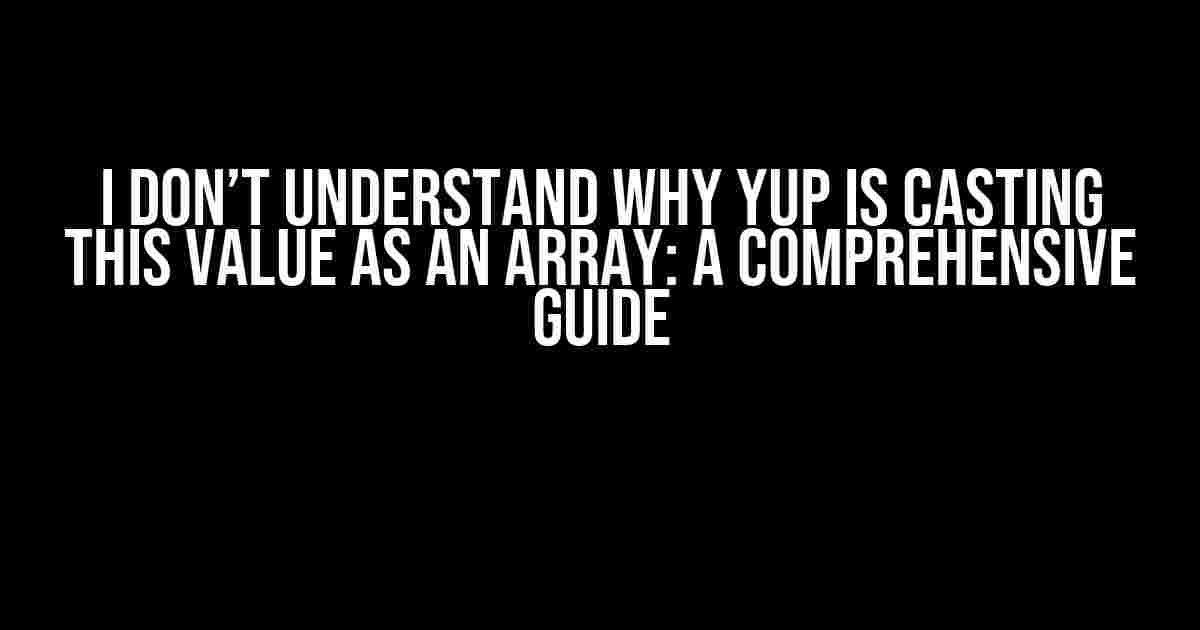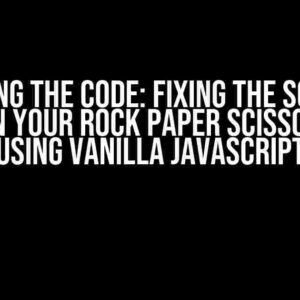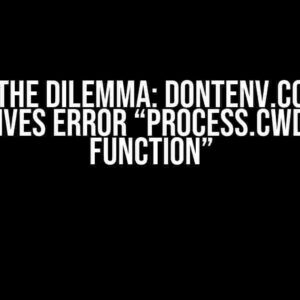Are you tired of scratching your head every time you encounter the infamous “Yup is casting this value as an array” error? Do you find yourself spending hours debugging your code, only to realize that Yup is the culprit? Well, fear not, dear developer! This article is here to demystify the reasons behind this error and provide you with a step-by-step guide to resolving it once and for all.
What is Yup, Anyway?
Before we dive into the meat of the matter, let’s take a quick look at what Yup is and why it’s an essential tool in many developers’ toolkits. Yup is a popular JavaScript library for object schema validation. It allows you to define a schema for your objects and then validate them against that schema, ensuring that your data is correct and consistent.
Yup is often used in conjunction with other popular libraries like React, Redux, and Axios to create robust and scalable applications. Its simplicity, flexibility, and robust feature set make it a favorite among developers.
So, Why is Yup Casting My Value as an Array?
Now, let’s get to the heart of the matter. There are several reasons why Yup might be casting your value as an array. Here are some of the most common culprits:
- Mismatched Types: One of the most common reasons for this error is a mismatch between the type of value you’re trying to validate and the type Yup expects. For example, if you’re trying to validate a string as an object, Yup will throw an error.
- Invalid Schema: Another reason for this error is an invalid schema definition. If your schema is malformed or incomplete, Yup will struggle to validate your data and may cast it as an array.
- Recursive References: Yup can get confused when dealing with recursive references in your schema. If you have a schema that references itself, Yup might cast your value as an array to avoid infinite looping.
- Optional Properties: Yup can also get tripped up when dealing with optional properties in your schema. If you have an optional property that’s not present in your data, Yup might cast the entire object as an array.
How to Fix the “Yup is Casting This Value as an Array” Error
Now that we’ve covered the common causes of this error, let’s dive into the solutions. Here are some step-by-step instructions to help you resolve the issue:
Step 1: Review Your Schema
The first step in resolving this error is to review your schema and ensure it’s correct and complete. Here are some best practices to keep in mind:
- Use the correct type for each property (e.g., string, number, object, etc.).
- Define required properties and mark optional properties as such.
- Avoid recursive references in your schema.
- Keep your schema simple and easy to read.
Here’s an example of a well-defined schema:
const schema = {
name: string().required(),
age: number().required(),
address: object().shape({
street: string().required(),
city: string().required(),
state: string().required(),
zip: string().required()
})
};
Step 2: Validate Your Data
Once you’ve reviewed your schema, it’s time to validate your data. Here’s an example of how to do it:
const data = {
name: 'John Doe',
age: 30,
address: {
street: '123 Main St',
city: 'Anytown',
state: 'CA',
zip: '12345'
}
};
try {
const validatedData = await schema.validate(data);
console.log(validatedData);
} catch (err) {
console.error(err);
}
Step 3: Debug Your Code
If you’re still encountering issues, it’s time to debug your code. Here are some tips to help you identify the problem:
- Use console.log statements to check the value of your data before validation.
- Use Yup’s built-in debugging tools, such as the
validateSync()method, to catch errors early. - Check the error message carefully to identify the property causing the issue.
- Use a debugger to step through your code and identify the point of failure.
Step 4: Use Yup’s Advanced Features
If you’re still struggling to resolve the issue, it’s time to bring in Yup’s advanced features. Here are a few options to consider:
- Use Yup’s
transform()method to convert your data before validation. - Use Yup’s
test()method to add custom validation rules. - Use Yup’s
default()method to set default values for optional properties.
Here’s an example of using the transform() method:
const schema = string()
.transform((value, originalValue) => {
if (originalValue instanceof Array) {
return originalValue.join(',');
}
return value;
});
Conclusion
In conclusion, the “Yup is casting this value as an array” error is a common issue that can be resolved with a little patience and practice. By reviewing your schema, validating your data, debugging your code, and using Yup’s advanced features, you can ensure that your data is correct and consistent.
Remember, Yup is a powerful tool that can help you create robust and scalable applications. With these tips and tricks, you’ll be well on your way to becoming a Yup master.
FAQs
Here are some frequently asked questions about Yup and the “Yup is casting this value as an array” error:
| Question | Answer |
|---|---|
| Why does Yup cast my value as an array? | Yup casts your value as an array when it encounters a mismatch between the type of value you’re trying to validate and the type Yup expects. |
| How do I resolve the “Yup is casting this value as an array” error? | Review your schema, validate your data, debug your code, and use Yup’s advanced features to resolve the error. |
| Can I use Yup with React? | Yes, Yup is often used with React to create robust and scalable applications. |
| Is Yup only for object validation? | No, Yup can be used for a wide range of validation tasks, including strings, numbers, and more. |
We hope this comprehensive guide has helped you understand and resolve the “Yup is casting this value as an array” error. Remember, with practice and patience, you can master Yup and create robust and scalable applications.
Frequently Asked Question
Yup, the library that’s supposed to make our lives easier, but sometimes it can be a little… confusing. Don’t worry, we’ve got you covered!
Why is Yup casting a single value as an array?
This is probably because Yup is trying to be too smart for its own good. When you pass a single value to a `array()` schema, Yup assumes you meant to pass an array with a single element, so it wraps your value in an array. You can avoid this by using the `lazy` function or by specifying the type explicitly.
Is this behavior specific to Yup?
No, this behavior is not unique to Yup. Other validation libraries, like Joi, exhibit similar behavior. It’s just how these libraries are designed to work.
How can I prevent Yup from casting a single value as an array?
You can use the `test` function to specify a custom validation function that ensures the value is not an array. Alternatively, you can use the `transform` function to transform the value before validation.
Is there a way to configure Yup to not cast single values as arrays by default?
Unfortunately, there is no global configuration option to change this behavior. You’ll need to use one of the workarounds mentioned earlier. However, you can create a custom schema that inherits from the built-in `array` schema and overrides the casting behavior.
What are some resources where I can learn more about Yup’s casting behavior?
You can check out the official Yup documentation, which has a section on casting and coercion. Additionally, there are many tutorials and blog posts online that cover Yup’s behavior in more detail. And, of course, you can always ask the community for help!




